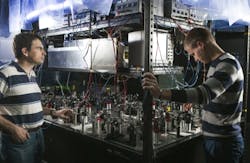Russian physicists restore the entanglement of 'untangled' quantum light
Scientists from the Russian Quantum Center (Moscow, Russia) have developed a method to restore quantum entanglement and have tested this method in an experiment in which they restored the level of quantum correlation between pulses of light in two optical channels. This research significantly broadens the possibilities of quantum communication and quantum cryptography.1 The work is a step towards building a quantum repeater.
The phenomenon of quantum entanglement (or quantum correlation) plays a particularly important role in secure quantum communication systems. However, entangled states are very fragile, breaking easily during transmission due to noise or optical losses. In addition, the very creation of entanglement is quite a difficult process. Existing equipment is only capable of transferring data at a distance of no more than 100 km. Many research groups are now looking for ways to increase this limited distance.
Recovery after 20-fold optical loss
Alexander Lvovsky’s group in the Quantum Optics Laboratory at the Russian Quantum Center conducted a series of experiments in which they restored the level of quantum correlation between pulses of light after it was almost completely destroyed after passing through a 20-fold optical loss. This corresponds to the level of loss in 65 km of ordinary fiber-optic cable.
A nonlinear optical crystal of periodically poled potassium titanyl phosphate was used as the source of entangled photons. Picosecond pulses of light generated by a titanium:sapphire laser were fired at the crystal. As a result, entangled photon pairs were produced in the crystal and directed into two different optical channels. In one of them, the light was subjected to 20-fold attenuation using darkened glass, causing the level of entanglement to fall almost to zero. Then an amplification procedure was applied, restoring the quantum properties of light in the channel to levels close to those that occurred before the loss.
The procedure is to mix the light pulse in the channel with a single auxiliary photon in a beamsplitter. A single-photon detector is placed at one of the outputs of the beamsplitter. If the detector clicks, this means that the photon has entered the beamsplitter and left. It would seem that the state of the second pulse to enter the beamsplitter (a part of the entangled state) should not change. But, because of paradoxical properties of quantum interference, the state changes in towards the strengthening of its quantum properties.
This phenomenon, discovered by Lvovsky and colleagues in 2002 (doi: 10.1103/PhysRevLett.88.250401), has been named quantum catalysis, because the auxiliary photon, like a chemical catalyst, is not itself involved in the reaction, but changes the state of light in the other channel.
Source: Russian Quantum Center
REFERENCE:
1. Alexander E. Ulanov et al., Nature Photonics (2015); doi: 10.1038/nphoton.2015.195

John Wallace | Senior Technical Editor (1998-2022)
John Wallace was with Laser Focus World for nearly 25 years, retiring in late June 2022. He obtained a bachelor's degree in mechanical engineering and physics at Rutgers University and a master's in optical engineering at the University of Rochester. Before becoming an editor, John worked as an engineer at RCA, Exxon, Eastman Kodak, and GCA Corporation.
